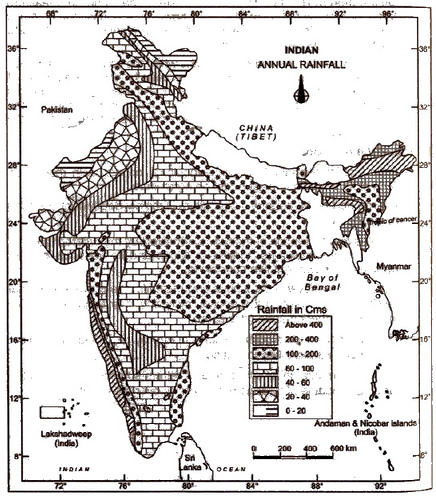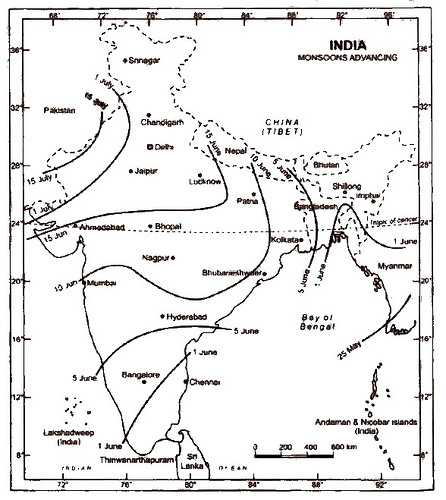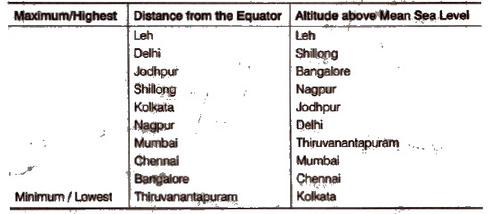Question 1. Choose the correct answer from the four alternatives given below
(a) Silchar
(b) Mawsynram
(c) Cherrapunji
(d) Guwahati
Answer : (b)
(ii) The wind blowing in the northern plains in summers is known as
(a) Kaal Baisakhi
(b) Loo
(c) Trade Winds
(d) None of these
Answer : (b)
(iii) Monsoon arrives in India approximately in
(a) early May
(b) early July
(c) early June
(d) early August
Answer : (c)
(v) Which one of the following characterises the cold weather season in India?
(a) Warm days and warm nights
(b) Warm days and cold nights
(c) Cool days and cold nights
(d) Cool days and warm nights
Answer : (b)
Question 2. Answer the following questions briefly.
(i) What are the controls affecting the climate of India?
Answer : There are six major controls of the climate of any place. They are latitude, altitude, pressure and wind system, distance from the sea (continentality), ocean currents and relief features.
(ii) Why does India have a monsoon type of climate?
Answer : The monsoon winds play an important role in the climate of India. Therefore, it is called the monsoon type of climate.
(iii) Which part of India does experience the highest diurnal range of temperature and why?
Answer : The north-western part of India experiences the highest diurnal range of temperature. In the Thar desert, the day temperature may rise to 50 0 e and drop down to near 15°e the same night. On the other hand, there is hardly any difference in day and night temperatures in the Andaman and Nicobar Islands or in Kerala .
(iv) Which winds account for rainfall along the Malabar coast?
Answer : The south west monsoon winds are responsible for the rainfall along the Malabar coast.
(v) Define monsoons. What do you understand by ‘break’ in monsoon?
Answer : The monsoons are moisture laden winds from the southwest which bring heavy rainfall to southern Asia, in summer.
‘Break’ in monsoon means that the monsoon has alternate wet and dry spells. This means that the monsoon rains take place for a few days at a time. These wet spells are interspersed with dry spells related to the movement of the monsoon trough.
(vi) Why is monsoon considered a unifying bond?
Answer : The seasonal alteration of the wind systems and the associated weather conditions provide a rhythmic cycle of seasons.
Monsoon rains are unevenly distributed and typically uncertain. The Indian landscape, plant and animal life, agriculture, the people and their festivities, all revolve around the monsoon.
All the Indian people eagerly await the arrival of the monsoon. It binds the whole country by providing water which sets all agricultural activities in motion. That is why the monsoon is considered a unifying bond.
Question 3. Why does rainfall decrease from the east to the west in northern India?
Answer : Rainfall decreases from the east to the west in Northern India because there is a decrease in the moisture of the winds. As the moisture bearing winds of the Bay of Bengal branch of the south west monsoon move further and further inland, the moisture gradually decreases and results in low rainfall when moving westwards. Consequently, states like Gujarat and Rajasthan in western India get very little rainfall.
Question 4. Give reasons as to why
(i) Seasonal reversal of wind direction takes place over the Indian subcontinent.
(ii) The bulk of rainfall in India is concentrated over a few months.
(iii) The Tamil Nadu coast receives winter rainfall.
(iv) The delta region of the eastern coast is frequently struck by cyclones.
(v) Parts of Rajasthan, Gujarat and the leeward side of the Western Ghats are drought prone.
Answer :
(i) During winter, there is a high pressure area north of the Himalayas. Cold winds blow from this region to the low pressure areas over the oceans to the south.
(a) In summer, a low pressure area develops over interior Asia as well as over north-western India.
(b) This causes a complete reversal of the direction of winds during summer.
(ii) In summer, a low pressure area develops over interior Asia as well as over north western India.
(a) This causes a complete reversal of the direction of winds during summer. Air moves from the high pressure area over the southern Indian ocean, crosses the equator and turns right towards the low pressure areas over the Indian subcontinent.
(b) These are known as the south-west monsoon winds.
(c) These winds blow over warm oceans, gather moisture and bring widespread rainfall over the mainland of India.
(d) The duration of the monsoon is between 100-120 days from early June to mid September. Thus, we can say that rainfall in India is concentrated over a few months.
(iii) During the winter season, -the north-west trade winds prevail over the country. They blow from land to sea and hence for most part of the country it is a dry season.
Some amount of rainfall occurs on the Tamil Nadu coast from these winds as here they blow from sea to land.
(iv) The delta region of the eastern coast is frequently struck by cyclones because the cyclonic depressions which originate over the Andaman Sea generally cross the Eastern coasts of India and cause heavy and widespread rain.
(a) These cyclones are often very destructive. The thickly populated deltas of the Godavari, the Krishna and the Kaveri are frequently struck by cyclones which cause great damage to life and property.
(b) Sometimes these cyclones arrive at the coasts of Odisha, West Bengal and Bangladesh.
(v) Parts of Rajasthan, Gujarat and the leeward side of the Western Ghats are drought prone because they receive scanty rainfall. Even during the monsoon months the monsoon winds when rising over the Western Ghats give rain to that area. By the time they reach Rajasthan and Gujarat there is very less moisture left in these winds and so these areas are drought prone.
Question 5. Describe the regional variations in the climatic conditions of India with the help of suitable examples.
Answer : There are regional variations in the climatic conditions of India which can be understood with the help of the following examples
(a) The months of December and January are the coldest in Northern India where the temperature ranges between 10°-15°.
(b) In summer, the mercury occasionally touches 50°C in some parts of the Rajasthan desert, whereas it might be around 2O°C in pahalgam In Jammu and Kashmir.
(c) On a winter night temperature at Drass in Jammu and Kashmir may be as low as minus 40″C. Tiruvananthapuram on the other hand may have a temperature of 22° C.
(d) Annual precipitation varies from over 400 em in Meghalaya to less than 10 cm in Ladakh and western Rajasthan. In the Himalayas precipitation is in the form of snowfall.
(e) Coastal region does not experience much variation in temperature pattern due to the moderating influence of the sea.
Question 6. Give an account of weather conditions and characteristics of the cold season.
Answer : The cold weather season begins from the November in northern India and stays till February. December and January are the coldest months
in the northern part of India.
(a) The weather is normally marked by clear sky, low temperatures, low humidity and feeble variable winds.
(b) Days are warm and nights are cold. Frost is common in the north and higher slopes of the Himalayas experience snowfall.
(c) During this season, the north-east trade winds blow from land to sea and hence for most parts of the country it is a dry season. Some amount of rainfall occurs on the Tamil Nadu coast from these winds as they blow there from sea to land.
(d) A characteristic feature of the cold weather season over the northern plains is the inflow of cyclonic disturbances from the west and the north-west. The low pressure systems originate over the Mediterranean Sea and Western Asia and move into India along with the westerly flow. They cause the much needed winter rains over the plains and snowfall in the mountains.
(e) Although, the total amount of winter rainfall locally known as ‘Mahawat’ is small, it is of immense importance for the cultivation of ‘rabi’ crops.
(f) The peninsular region does not have a well defined cold season. There is hardly any noticeable change in temperature pattern during winter due to the moderating influence of the sea.
Question 8. Give the characteristics and effects of the monsoon rainfall in India.
Answer: Characteristics
(a) The climate of India is described as the ‘monsoon’ type.
(b) Monsoon refers to the seasonal reversal in the wind direction during the year.
(c) The duration of monsoon is between 100-120 days from early June to mid September. Around the time of its arrival, the normal rainfall increases suddenly and continues constantly for several days. This is known as ‘burst’ of the monsoon.
(d) The monsoon has a tendency to have ‘breaks’; thus, it has wet and dry spells. In other words, monsoon rains take place only for a few days at a time.
(e) The monsoon is known for its uncertainties.
(f) The alternation of dry and wet spells vary in intensity, frequency and duration.
(g) Distribution of Rainfall Parts of the western coast and north-eastern India receive over 400 cm of rainfall; however, it is less than 60 cm in western Rajasthan and parts of Gujarat, Haryana and Punjab. Kashmir also receives low rainfall.
The withdrawal of the monsoon begins when the south-west monsoon winds weaken and start withdrawing gradually. By the beginning of October, the monsoon withdrawal from the northern plains. By mid October, it withdraws completely from the northern half of the peninsula. By early December, the monsoon has withdrawn from the rest of India.
Effects of the Monsoon
(a) India has traditionally been an agricultural country with more than 50% of its population dependent on agriculture.
(b) A large part of the country’s agriculture is mainly dependent upon the monsoon rains.
(c) There is great variation in the rainfall received by the different parts of the country, somewhere it leads to floods and its absence in other parts leads to drought like conditions.
(d) The Indian landscape, its animal and plant life, the entire agricultural calendar and the life of the people, including their festivities revolve around this phenomenon (monsoon).
(e) The monsoon winds bind the whole country by providing water to set the agricultural activities in motion.
It is often irregular in its arrival and its retreat sometimes disturbs the farming schedule of millions of farmers all over the country.
Map Skills
On an outline map of India, show the following
(i) Areas receiving rainfall over 400 cm.
(ii) Areas receiving less than 20 em of rainfall.
(iii) The direction of the south-west monsoon over India.
Answer : (i) and (ii)
For doing it yourself
Question 1. Re-arrange the ten stations in two different sequences
(i) According to their distance from the equator.
(ii) According to their altitude above mean sea-level.
Answer :
Question 2.
(i) Name two rainiest stations.
Answer : Shillong and Mumbai.
(ii) Name two driest stations.
Answer : Leh and Jodhpur.
(iii) Name two stations with most equable climate.
Answer : Thiruvananthapuram and Mumbai.
(iv) Name two stations with most extreme climate.
Answer : Leh and Jodhpur.
(v) Name two stations most influenced by the Arabian branch of south-west monsoons.
Answer : Mumbai and Thiruvananthapuram.
(vi) Name two stations most influenced by the Bay of Bengal branch of south-west monsoons.
Answer : Shillong and Kolkata.
(vii) Name two stations influenced by both branches of the south-west monsoons.
Answer : Delhi and Nagpur.
(viii) Name two stations influenced by retreating and north-east monsoons.
Answer : Thiruvananthapuram and Chennai
(ix) Name two stations receiving winter showers from the western disturbances.
Answer : Delhi and Kolkata.
(x) Name two hottest stations in the months of
(a) February
(b) April
(c) May
(d) June
Answer :
(a) Thiruvananthapuram and Chennai.
(b) Nagpur and Chennai.
(c) Nagpur and Delhi I Jodhpur.
(d) Jodhpur and Delhi.
Question 3. Now find out
(i) Why are Thiruvananthapuram and Shillong rainier in June than in July?
Answer : They are rainier in June as the monsoon’s arrival occurs in both places in June and the initial impact of the monsoon is an intense period of heavy rain.
(ii) Why is July rainier in Mumbai than in Thiruvananthapuram?
Answer : The monsoon reaches Mumbai about 10 days after Thiruvananthapuram and so the initial impact- of the monsoon continues into the next month. After the first initial downpour the monsoon falls into a steady pattern of raining for at least a couple of hours most days. So, it reduces in Thiruvananthapuram earlier than in Mumbai.
(iii) Why are south-west monsoons less rainy in Chennai?
Answer : Chennai doesn’t receive much rain during the south-west monsoon, as the south of India (the states of Tamil Nadu, Karnataka, and Kerala) gets most of its rainfall from the north-east monsoon, from October to December.
(iv) Why is Shillong rainier than Kolkata?
Answer : Shillong is in a hilly area and the hills trap the monsoon winds, so that Shillong becomes rainier than Kolkata.
(v) Why is Kolkata rainier in July than in June unlike Shillong which is rainier in June than in July?
Answer : The monsoon reaches Shillong earlier than Kolkata (refer to the ‘Advancing Monsoon’ map in your textbook) and the initial impact is heavier than the later showers. So, Shillong is rainier in June while Kolkata is rainier in July.
(vi) Why does Delhi receive more rain than Jodhpur?
Answer : Jodhpur is on the edge of the Thar Desert and by the time the monsoon winds reach it, most of their moisture is finished. Delhi is more east than Jodhpur and so it receives more rainfall.
Question 4. Now think why
(i) Thiruvananthapuram has equable climate?
Answer : Thiruvananthapuram has equable climate because of two reasons.
(a) It is on the sea coast. The moderating influence of the sea makes the climate equable.
(b) It is near to the equator. At the equator, all the seasons have similar temperatures and so this makes the climate equable.
(ii) Chennai has more rains only after the fury of monsoon is over in most parts of the country?
Answer : Chennai receives most of its rainfall from the north-east monsoon, which gives rains mostly from October to December, and not the south-west monsoon. That is why Chennai gets most of its rainfall later than most other parts of the country.
(iii) Jodhpur has a hot desert type of climate?
Answer : Jodhpur is in the extreme western part of India and so, when the monsoon winds reach it, they have exhausted their moisture. Further it is on the edge of the Thar Desert. That is why it has a hot desert type of climate.
(iv) Leh has moderate precipitation almost throughout the year?
Answer : Leh is in the ‘cold desert’ called Ladakh, which is a valley in between two mountain ranges. No monsoon winds are able to reach it. That is why it has moderate precipitation almost throughout the year.
(v) While in Delhi and Jodhpur most of the rain is confined to nearly three months, in Thiruvananthapuram and Shillong it is almost nine months of the year?
Answer : Thiruvananthapuram is on the sea coast and so it receives rainfall from both the southwest and north-east monsoons, besides receiving rainfall due to local disturbances which pick up moisture from the sea. Shillong is in a hilly area and so receives rain from the monsoon as well as from local disturbances which are trapped by the hills.
(vi) In spite of these facts see carefully if there are strong evidences to conclude that the monsoons still provide a very strong framework lending overall climatic unity to the whole country.
Answer : The seasonal alteration of the wind systems and the associated weather conditions provide a rhythmic cycle of seasons. Monsoon rains are unevenly distributed and typically uncertain. The Indian landscape, plant and animal life, agriculture, the people and their festivities, all revolve around the monsoon.
All the Indian people eagerly await the arrival of the monsoon. It binds the whole country by providing water which sets all agricultural activities in motion. That is why the monsoon is considered a unifying bond.




Very nice 😊